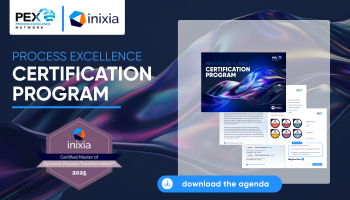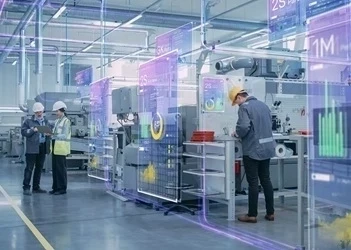How process mining keeps powering business success
Modern enterprises value speed and size, but process mining is still the field that gives them clarity and control
Add bookmark
How does process mining keep powering business success? There have been significant shifts in the way people talk about enterprise automation in the last few years. Terms like agentic artificial intelligence (AI), hyperautomation and process intelligence have become highly prevalent. These improvements are great, but the idea that “process mining is dead” is not only wrong, it could also be detrimental.
I have been in this industry for more than a decade now, delivering automation programs across the insurance, healthcare, BFSI and manufacturing sectors. Based on what I’ve seen, I can confidently say that process mining holds a hidden stack of opportunities every business can act on to reap ultimate value in their workflows.
Join the PEX Network community

Don't miss any news, updates or insider tips from PEX Network by getting them delivered to your inbox. Sign up to our newsletter and join our community of experts.
Learn MoreProcess mining: What is it?
People often think of process mining as just a “discovery tool,” but it’s more than that. It makes accurate process maps by looking at system event logs. These maps show exactly how your business processes work in real time. It brings to light the friction points, manual deviations, compliance gaps and performance problems that usually go unnoticed.
Traditional process analysis used interviews, guesswork and old standard operating procedures (SOPs). Process mining, on the other hand, gives you data-driven truth, and in enterprise automation, the truth is everything.’
Why process mining still matters as a diagnostic and planning tool
Let’s look at where process mining remains useful in 2025:
- Transparent transformation: You can’t automate what you can’t see, so be open about what you’re doing. Process mining gives you a full picture of how things really work, across all systems and teams.
- Finding opportunities: It helps bring to light inefficiencies, redundancies and variations, important information when choosing where to automate.
- Prioritization and ROI tracking: Not all processes should be automated. You can use process mining to figure out how much work is needed and how much impact it will have, and to see how benefits change over time.
- Governance and compliance: You can compare what happens in real time to models that have already been set up to make sure that service level agreements (SLAs) and compliance rules are followed.
- Optimization and continuous improvement: Process mining tools let you keep an eye on things all the time so you can change and improve your automation strategies on the fly.
Where process mining fits in the process intelligence stack
People often confuse process mining and process intelligence. The latter often includes things like task mining, real-time monitoring, simulation and predictive analytics. Yes, it is wider in scope, but it doesn’t make process mining obsolete; it makes it essential.
Process mining is the foundation of process intelligence. Not doing process mining is like not doing diagnostics before getting treatment.
This is how you should think of it:
- Process mining is like an X-ray of your current workflow.
- Process intelligence = diagnosis + prediction + ongoing prescription.
- You need both, but you can’t skip the scan!
A lot of people still think of process mining as a way to find issues but it works even better when combined with automation technologies. This synergy makes process mining more than just a step in the process. It turns it into the control tower and a feedback loop for getting better outcomes:
- Robotic process automation (RPA): Finds stable, rules-based tasks that can be automated and makes sure that performance stays at its best after deployment.
- AI: Shows where cognitive technologies can be stacked on top of each other, such as for decisions, exceptions or classifications.
- AI agents: Gives agents orchestration insights that let them work together even when the process changes.
Register for All Access: Revolution in Process Intelligence APAC 2025!
How process mining powers automation governance and value realization
This is how process mining fits into the 2025 automation stack:
Discovery layer
Process mining and task mining work together at the start of any automation project to give a full, data-backed picture of both system-level flows and user-level actions. They all work together to give you the basic information you need to choose the right processes to automate.
Governance layer
In a time when automation centers of excellence (CoEs) are supposed to help with strategic goals, process mining is like the dashboard behind the dashboard. It feeds governance frameworks with real-time performance metrics, deviation tracking and compliance insights. This makes sure that automation projects are not only put into action but also watched, evaluated and improved over time.
Optimization layer
Process mining helps with ongoing optimization even after the go-live phase. It shows where there are problems, keeps track of changes in performance after automation and finds new ways to redesign or improve things. This layer helps keep things flexible and adaptable, whether you’re working with processes that have a lot of exceptions or expanding into new areas.
Watch: Navigating the 2025 process mining landscape: Current and future trends
Process mining: Real world applications
Here are two studies which used process mining to improve processes and multiplied ROIs:
Banking and finance
The success story of know your customer (KYC) automation shows how process mining principles like deep process visibility, continuous monitoring and iterative optimization can lead to scalable automation results. We identified problems with the client’s original RPA implementation and improved process clarity through structured documentation and real-time monitoring. This led to a 566 percent increase in evaluation capacity and a $1.5 million ROI in just eight months.
This case shows that operational intelligence powered by process mining insights can not only fix broken automations but also turn them into systems that can grow and be governed, which helps businesses grow.
Manufacturing
A global chemical manufacturing company is a good example of how process mining can help businesses save money and make things clearer. The team found $20 million in potential working capital impact by mapping differences between purchase orders, contracts and invoices. This information would have been lost without data-driven discovery.
Process mining was more than just a way to find problems; it helped the client make a 12-month automation plan, improve procurement governance and move toward making decisions before they happen. This case shows that process mining isn’t just a legacy solution in industries that are complicated and need a lot of money; it’s the key to strategic, insight-led change.
Join us at All Access: BPM Business Process Management 2025!
How leading enterprises are different
Companies that are ahead of the curve aren’t getting rid of process mining; instead, they’re making it a more powerful and connected part of their automation stack. Here’s what they’re doing differently:
Putting process mining together with orchestration layers
Instead of using mining as a one-time diagnostic, top companies build it right into orchestration platforms so they can make decisions in real time. These insights help automation orchestrators change on the fly, sending tasks to different places or starting exceptions with accuracy.
Using AI to predict process issues before they happen
Not only are top companies looking at how things have gone in the past, they are also using process mining data to create predictive models. This lets them plan for breakdowns or SLA risks and do something about them before they happen.
Putting mining insights into CoE governance dashboards
Instead of keeping process mining in separate reports, more advanced organizations put it right into the dashboards that automation and IT CoEs use. This gives leaders a constant sense of how well processes are working, how much value automation is bringing and where there is room for improvement.
Simulating automation changes
Smart companies don't just automate things without thinking. They use process mining to create models of different change scenarios and see how changes, such as adding bots or changing workflows, will affect the results. This makes deployments less risky and helps with quick decision-making.
Why I still bet on process mining
Almost all enterprises value speed and size, but process mining is still the field that gives them clarity and control. Without it, businesses could end up automating chaos. So no, process mining isn’t dead. It’s your guide to automation, and as we make systems that are smarter and more autonomous, this compass is what keeps us on track.
It’s time to rethink your process mining strategy if you want to confidently scale automation in your business. Success in the age of AI and automation won’t come from just being fast; it will come from smart, open and controlled change. Process mining makes sure that the path to new ideas is based on facts, not guesses.
Professional Process Excellence Certification Provided by Inixia in Partnership with PEX Network

Designed for today’s fast-paced, competitive business landscape, this certification signals a deep capability in operational excellence and innovation. It enables professionals to lead process transformation across functions and industries, and become change agents within their organizations. Whether you're advancing your career or strengthening your team’s performance, the Certified Master of Dynamic Process Transformation provides a forward-thinking, results-driven approach to creating sustainable value and long-term success.
Learn More












